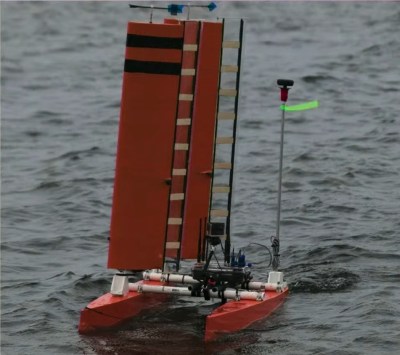Sailing the high seas with the wind conjures a romantic notion of grizzled sailors fending off pirates and sea monsters, but until the 1920s, wind-powered vessels were the primary way goods traveled the sea. The meager weather-prediction capabilities of the early 20th Century spelled the end of the sailing ship for most cargo, but cargo ships currently spend half of their operating budget on fuel. Between the costs and growing environmental concerns, [Pierce Nichols] thinks the time may be right for a return to sails.
[Nichols] grew up on a sailing vessel with his parents, and later worked in the aerospace industry designing rockets and aircraft control surfaces. Since sailing is predominantly an exercise in balancing the aerodynamic forces of the sails with the hydrodynamic forces acting on the keel, rudder, and hull of the boat, he’s the perfect man for the job.
While the first sails developed by humans were simple drag devices, sailors eventually developed airfoil sails that allow sailing in directions other than downwind. A polar diagram for a vessel gives you a useful chart of how fast it can go at a given angle to the wind. Sailing directly into the wind is also known as being “in irons” as it doesn’t get you anywhere, but most other angles are viable.
the first sails developed by humans were simple drag devices, sailors eventually developed airfoil sails that allow sailing in directions other than downwind. A polar diagram for a vessel gives you a useful chart of how fast it can go at a given angle to the wind. Sailing directly into the wind is also known as being “in irons” as it doesn’t get you anywhere, but most other angles are viable.
After a late night hackerspace conversation of how it would be cool to circumnavigate the globe with a robotic sailboat, [Nichols] assembled a team to move the project from “wouldn’t it be cool” to reality with the Pathfinder Prototype. Present at the talk, this small catamaran uses two wing sails to provide its primary propulsion. Wing sails, being a solid piece, are easier for computers to control since soft sails often exhibit strange boundary conditions where they stop responding to inputs as expected.
In its first iteration,  Pathfinder was controlled with Ardupilot and servos directly attached to the wing sails. For this application, [Nichols] and his team found that the program was unable to successfully navigate multiple points and was difficult to edit due to its monolithic nature. A rebuild of the boat with a new cellular modem instead of Wi-Fi, bigger batteries, and a power switch changed to PX4 for control. They found that using cross-tack error, or the deviation from a straight line between waypoints works well for confined waters with well-documented hazards, but in open water “best velocity made good” can be more efficient.
Pathfinder was controlled with Ardupilot and servos directly attached to the wing sails. For this application, [Nichols] and his team found that the program was unable to successfully navigate multiple points and was difficult to edit due to its monolithic nature. A rebuild of the boat with a new cellular modem instead of Wi-Fi, bigger batteries, and a power switch changed to PX4 for control. They found that using cross-tack error, or the deviation from a straight line between waypoints works well for confined waters with well-documented hazards, but in open water “best velocity made good” can be more efficient.
With some experience under their belt, the crew was able to secure funding to build a larger test vessel. With a cheap catamaran and 400 square feet of rental space, this vessel was equipped with two wing sails on one of the hulls and commenced testing in the Puget Sound. Keeping the wing sails on a single hull keeps the deck clear for cargo without significantly affecting performance.
Despite some setbacks, like breaking apart and sinking, the new vessel is yielding lots of interesting data which will lead to the first operating full-scale vessels. These will be designed to carry one or two ISO standard shipping containers to rural locations. Current regulations require a small crew aboard the boat, but [Nichols] hopes that the research they’ve been doing on autonomous vessel control will lead to fully autonomous trips in the future to help make deliveries to Alaska or other remote places more economical.
Further down the line, larger vessels will be able to handle hundreds or thousands of containers. Toward the end of the talk, [Nichols] gave us a list of resources for anyone interested in pursuing nautical hacks including many works by C.A. Marchaj or looking into the Amateur Yacht Research Society to “do weird things with sailboats.”
